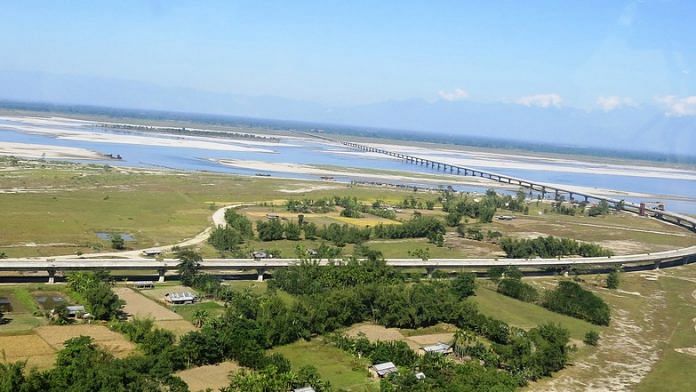New Delhi: The Narendra Modi cabinet has approved the construction of the Dhubri-Phulbari bridge over the Brahmaputra, which, when completed, will become India’s longest bridge.
The 19.8-km-long bridge had been proposed four years ago by the National Highways and Infrastructure Development Corporation Limited (NHIDCL), which falls under the Ministry of Road Transport and Highways, to reduce the distance between Dhubri in Assam and Phulbari in Meghalaya.
The bridge will replace the 9.1-km-long Bhupen Hazarika Setu, also known as the Dhola-Sadiya Bridge in eastern Assam, as India’s longest bridge.
Dhubri and Phulbari lie on either bank of the extremely wide Brahmaputra just before it flows into Bangladesh. But the road distance between them is currently about 210 km, via the Naranarayana Setu between the Bongaigaon and Goalpara districts.
“In the past, the easiest and fastest way to travel between Dhubri and Phulbari was by motorboat, and even that took about three hours,” said Manmohan Deol, general manager (technical) of the NHIDCL. “In the rainy season, the journey was impossible because the Brahmaputra usually flows above the danger mark. Even otherwise, travel on this route would depend on the availability of motorboats.”
The project involves a total capital cost of about Rs 5,000 crore. It will be built under Phase 3 of the Northeast Road Network Connectivity Project, with the Japan International Cooperation Agency providing the loan.
Also read: Bogibeel bridge, India’s longest rail-cum-road bridge, opens in Assam today
Socio-economic impact of the bridge
Once the bridge is complete, it is likely to serve more than 20 lakh commuters every year, and is expected to have a huge socio-economic impact on the two regions.
Phulbari is in a remote part of Meghalaya’s West Garo Hills district, and people of the region do not have a hospital nearby — they have to rely on the district hospital in Dhubri, which is quite inaccessible in an emergency.
Both regions lag behind on a lot of other indicators too, but with the new bridge, there is hope of upliftment.
“Besides minimising the traffic congestion on this route, the bridge will provide connectivity to urban markets and supply chains. It will enhance connectivity and interactions between the rural and urban population, and an improved access to higher education facilities and modern health facilities will be available,” said Deol.
In addition, the bridge will also help international connectivity in the region, given its proximity to both Bangladesh and Bhutan.
According to NHIDCL managing director N.N. Sinha, the improved connectivity will enhance the reach and export of perishable farm goods from Meghalaya and Assam to these two neighbouring countries.
The Dolphin conundrum
During the NHIDCL’s feasibility study, about 25 Gangetic dolphins were observed in the stretch where the bridge is proposed to be constructed. These dolphins are an endangered species endemic to the Ganga-Brahmaputra river system. Their eyes are mere pin-holes, so they are considered blind dolphins who work on acoustics, and there were concerns that construction work would destroy them.
The NHIDCL then hired professor Sunil Kumar Choudhary, a dolphin expert from Bhagalpur University in Bihar, to conduct an elaborate study and provide a solution to protect the dolphins.
Choudhary has suggested installing observatory towers, so that construction work can be immediately stopped when a dolphin is observed, monitoring construction sounds, and making sure that water in that stretch is not made turbid.
Also read: SC pulls up Haryana govt for ‘shocking’ amendment allowing construction in Aravallis




Misleading information. It connects assam and arunachal,Not assam and Meghalaya